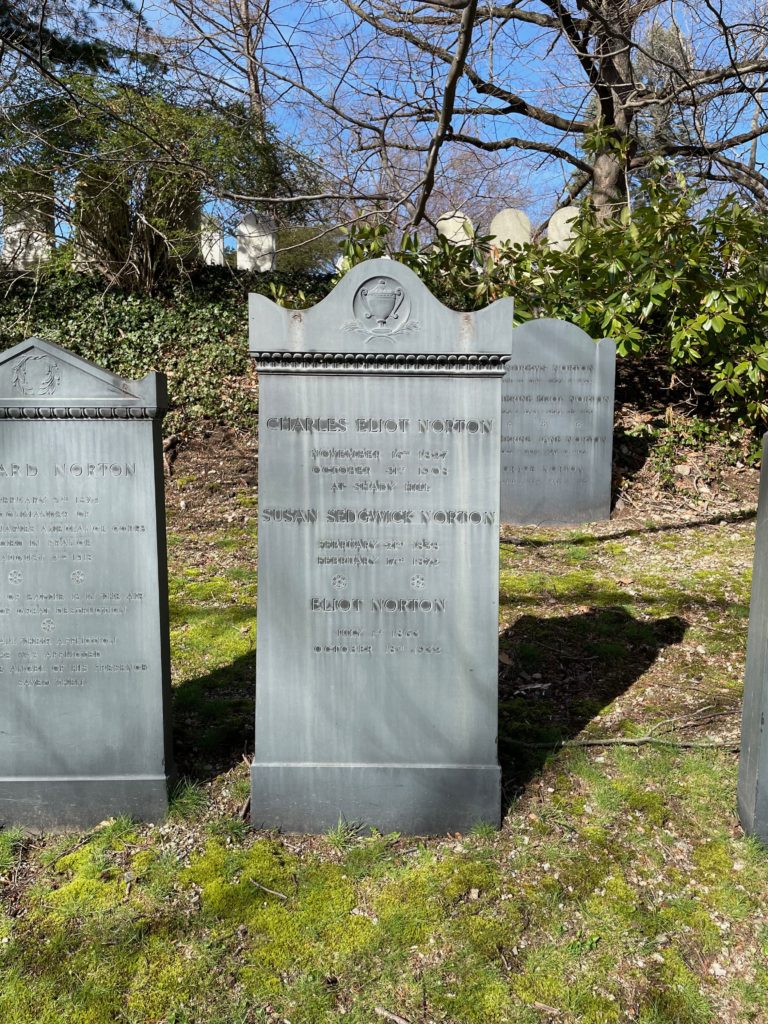Erik Visits an American Grave, Part 1,095
This is the grave of Charles Eliot Norton.

Born in Cambridge, Massachusetts in 1827, Norton grew up in the most elite classes of Boston. No one could out-Brahmim Norton. His father was a Harvard theologian and his mother came out of the merchant classes. His cousin was president of Harvard. It may not surprise you that Norton himself would then go to Harvard, where he graduated in 1846.
At first, Norton decided to follow his mother’s family and go into business. In fact, he sailed from Boston to India in 1849 on a business trip, though I’m sure there was plenty of seeing the world in that as well. In fact, he then messed around Europe for a couple of years. This was some classic Grand Tour stuff, though with the Puritanism that drove this class making sure not too much fun was had. Norton came back to the U.S. in 1851 and decided that his father’s calling made more sense than his mother’s. He went into the intellectual life and writing. He became arguably the nation’s leading art critic in the 1850s, having been blown away by seeing the pre-Raphalite artists’ work in Europe. He also became a leading translator of Dante and worked on various projects around the great author throughout his life, with some work being published in the 1860s and some not until after Norton’s death. His Dante translations brought him his greatest fame.
Norton’s politics were usually pretty typical of the Republican elites with whom he surrounded himself. There was no way Norton was going to serve in the military during the Civil War. I imagine he bought himself out of that easily enough. But he was active in the Loyal Publication Society, which was basically a proto-propaganda organization designed to send pro-Union editorials and literature around the country. Also typical of being a good rich Republican in these years was contempt toward the Irish and Norton most certainly had plenty of that. He really did not like these people who from his perspective should have good Europeans but then did not act like he thought that meant. So he opposed the opening of a saloon near his home in Boston because it would attract Irish drinkers.
During the war, in 1864, Norton also started The North American Review. This was at the time when he was becoming one of the premier intellectuals in the United States. Of course was that really meant was acceptance in Europe, which was certainly on his agenda. He spent much of his time over the next twenty years in England and on the continent, meeting with and talking to the leading intellectual lights of the day. Whether they respected him as much as he respected them, I do not know. He did teach at Harvard starting in 1874, but this seems to have been as much about whenever he was around than actual academic duties. In any case, he became particularly close with such British intellectuals as Thomas Carlyle and John Ruskin. In fact, he became a top promoter of Carlyle’s work, editing and publishing much of it. That includes Letters of Carlyle and Emerson in the mid 1880s and Carlyle’s Letters and Reminiscences, also from that era.
Norton also wrote some travelogues and histories. These absolutely reflected his love for Europe, which for any American trying to impress the world was the only place that mattered. Notes of Travel and Study in Italy probably is a bit more interesting that the title suggests. That he published in 1859. In 1880, he went back to his Italian interest and published Historical Study of Church-building in the Middle Ages: Venice, Siena, Florence. He didn’t only travel in Europe though. He also traveled in India and wrote about that too. At the same time, he was important in promoting the arts and crafts movement in the United States and provided some of the key intellectual approval of this solid artistic movement. He was also the first director of the Archaeological Institute of America. He took on the reform politics of the late nineteenth century. He was a big promoter of civil service reform, desperately needed in the incredibly corrupt Gilded Age. He also strongly opposed imperialism as most of the Republican Party embraced it during the late 1890s. He was vice-president of the New England Anti-Imperialist League from 1899 to 1904 and then helped reorganize the national Anti-Imperialist League in 1904, being involved with that until his death.
As Norton aged, he realized that getting old was terrible. He’s hardly the first person to realize this and yeah. But what made Norton really quite unique for his time is that he became an advocate for legalizing euthanasia. In this, he was following a woman named Anna Hall, who was a rich socialite herself, to push for allowing people the freedom to end their own lives. There were bills in Ohio and Iowa to legalize it. This movement died and really didn’t revive until the 1990s. Today, it is legal in Oregon and I am surprised there hasn’t been a great move to expand this.
In any case, Norton himself died in 1908 in the house where he was born. He was 80 years old.
Charles Eliot Norton is buried in Mount Auburn Cemetery, Cambridge, Massachusetts.
If you would like this series to visit other Gilded Age intellectuals, you can donate to cover the required expenses here. Because these people were so Boston-centric, I’ve already covered a lot of them, but there’s always more stories to tell. Edward Youmans is in The Bronx and Frederick Jackson Turner is in Madison, Wisconsin. Previous posts in this series are archived here.


